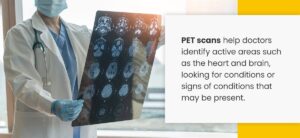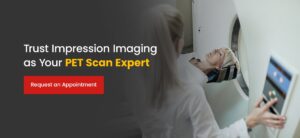
A positron emission tomography (PET) scan is an essential tool medical professionals use to diagnose different health conditions. Without PET body scans, it would be challenging for doctors to diagnose individuals accurately and provide appropriate care. Below, you’ll learn how PET scans work and what doctors use them for.
How Do PET Scans Work?
A PET scan measures metabolic activity in the body tissue’s cells. First, a small dose of radioactive glucose, a type of sugar referred to as the radiotracer, is administered intravenously. The PET scanner then takes images of where the glucose collects in the brain because they accumulate around malignant cells.
The PET scanner can detect malignant lesions that magnetic resonance imaging (MRI), computerized tomography (CT) scans or X-rays missed, allowing medical professionals to provide an accurate diagnosis. PET scans help doctors see biochemical changes within the body, such as the metabolism in body tissues or areas where cells are more active than usual. While PET scans work similarly to CT scans, PET scans can detect live cancer tissue.
Sometimes, PET scans are combined with CT scans, called PET-CT scans. Combining the two scans allows for more detailed imaging for accurate diagnosis. If you’re going in for a PET scan, you can expect the exam to last 45-60 minutes so the radiographer can take all the necessary images. Patients may have up to an hour beforehand to receive a radiotracer injection or the radioactive glucose required for the scan.

What Are PET Scans Used for?
PET scans help doctors identify active areas such as the heart and brain, looking for conditions or signs of conditions that may be present. These scans will also measure oxygen intake, blood flow and the metabolism of tissues or organs:
- Heart problems: PET scans are ideal for revealing decreased blood flow in the heart vessels. Unhealthy heart tissue won’t take in as much of the radiotracer, making them easy to identify. Varying colors and brightness levels help doctors identify different levels of tissue function, allowing you and a medical professional to make informed decisions when moving forward with your treatment.
- Brain disorders: The radiotracer will be more active in specific parts of the brain than others, allowing doctors to identify various central nervous system (CNS) conditions, such as epilepsy and Alzheimer’s disease. PET scans can also help determine the severity of these conditions, assisting with the next steps for treatment.
PET scans diagnose numerous conditions but are primarily used with cancer patients. PET scans are beneficial because they can detect and accurately stage most cancers, sometimes before other tests can.
PET scans can also show additional valuable information, such as:
- Depicting the effectiveness of current treatment
- Showing where in the body is the best place for a biopsy
- Checking for new cancer growth, both after treatment and during followups
- Determining the best course of action for radiation therapy
- Restaging a cancer diagnosis
PET scans are a vital tool to help medical professionals discover different conditions in patients and find the best form of treatment to garner the most success. PET scans are particularly successful at determining whether a tumor is malignant or benign, especially when combined with CT scans, helping doctors decide which treatment best suits each individual.
How to Prepare for a PET Scan
Preparing for a PET scan can limit surprises and ensure you’re comfortable throughout the exam. You should take different steps before, during and after the scan, which we outline below.
Before the Scan
Before the scan, avoid eating for four to six hours, limiting yourself to unflavored water. If you have diabetes and not eating is a problem, call your doctor to determine if you need to adapt your diet before the scan. Your doctor may also ask you to avoid strenuous exercise for up to 24 hours before your appointment.
Other ways you’ll need to prepare for the scan include:
- Dressing accordingly: A technologist may ask you to change into a medical gown during your scan, so you’ll want to wear loose-fitting clothing that’s easy to change. If you’re not required to change, wearing loose clothing will help keep you comfortable. You’ll need to remove any jewelry, piercings or other metal items, so they don’t interfere with the scan. If you have any metal implants, let your doctor know ahead of time.
- Bringing your medical records: Your medical history is essential before performing any exam, including PET scans. Bring your medical records or be aware of what you’ve done in the past, as your technologist will likely ask you questions about your history, including other scans or surgeries you may have had. You’ll also want to mention what medications you’re taking and what you’re using them for.
- Reviewing your instructions: You’ll likely receive instructions letting you know what you can eat and drink before the procedure. Review these instructions carefully to ensure you don’t miss anything before the exam.
- Allotting plenty of time: You’ll likely be at your appointment between one to three hours since a doctor will need to give you the radiotracer, giving it up to 90 minutes to travel through your body. The scan could take up to an hour. You’ll want to plan your day so you have plenty of time to complete the exam and the rest of your daily activities.
- Leaning on family or friends: If you’re anxious about your scan, talking with friends or family members can help you feel more comfortable. You may also be able to bring support into the facility with you if they approve of guests.
During the Scan
Be prepared to have an injection for the radiotracer. You should also be prepared to lie on a surface that slides into a large machine with a doughnut shape in the middle. At specific points during the scan, the technician may ask you to hold your breath for a few seconds to get clear images, as moving too much can cause the images to be inaccurate.
If you’re anxious about your exam, talk to your technician. They can help you be more comfortable, making potential accommodations as necessary to help get the images needed for your future treatment.
After the Scan
Once the scan is complete, you can continue eating, drinking and exercising as usual. It’s a good idea to drink more water shortly after the exam to flush out the dye or radioactive sugar. You’re free to go about your day when the scan is done.
Trust Impression Imaging as Your PET Scan Expert
Impression Imaging utilizes advanced PET scanners to help doctors diagnose and monitor different conditions. Once we perform our scans, we send the necessary information to your doctor to ensure they have everything they need to coordinate your care. We aim to make the process as easy as possible for our patients, providing quick scheduling and quality customer service.
If you’re interested in our imaging services, fill out our contact form to get in touch today!



